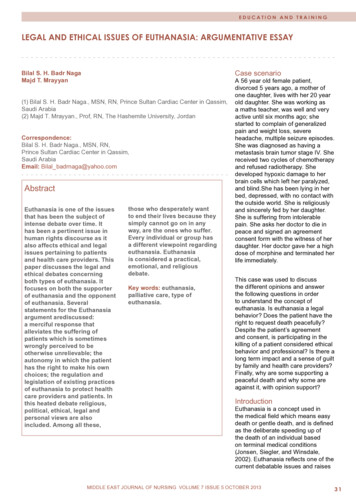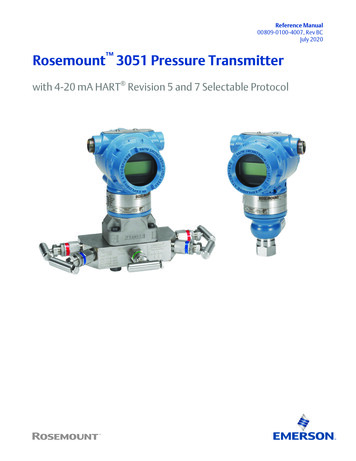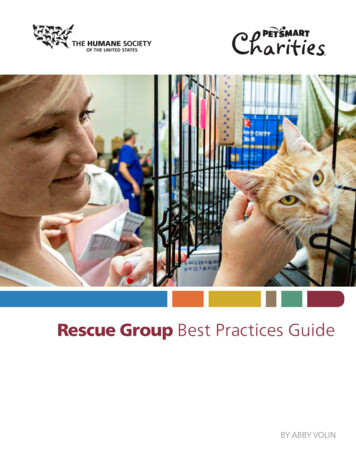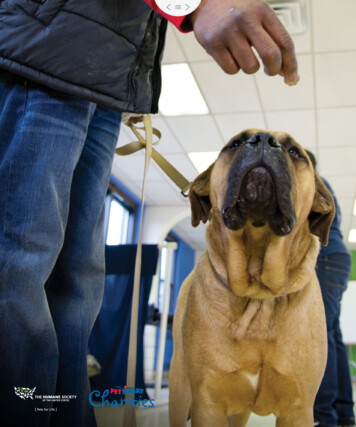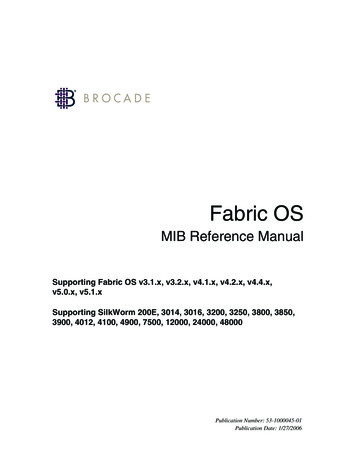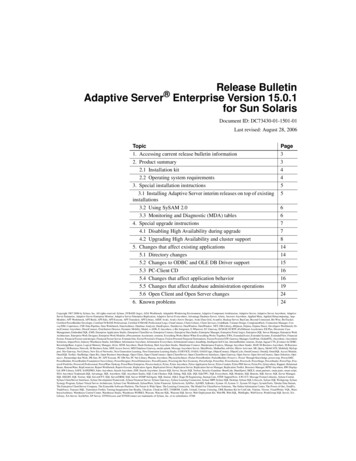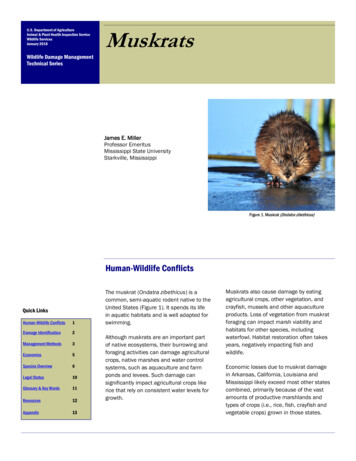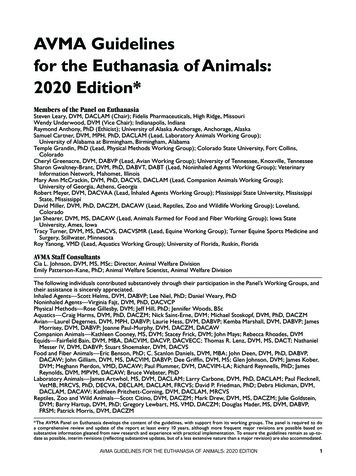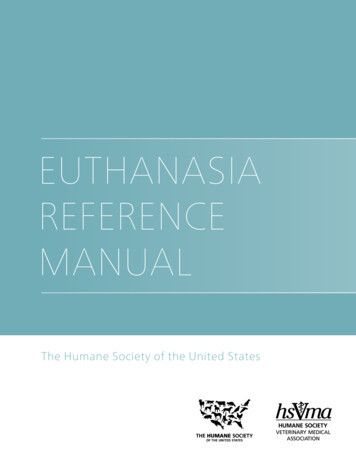
Transcription
EUTHANASIAREFERENCEMANUALThe Humane Society of the United States
EUTHANASIAREFERENCEMANUALThe Humane Society of the United States
Copyright 2013 by The Humane Society of the United States. All rights reserved.No portion of this book may be reproduced in any form or by any electronic or mechanical means,including information storage and retrieval systems, without permission in writing from the publisher.Second editionISBN 978-1-934785-03-4978-1-934785-04-1Library of Congress Cataloging-in-Publication Number: TXu 1-866-347iiThe Humane Society of the United States Euthanasia Reference Manual
Acknowledgments. . . . . . . . . . . . . . . . . . . . . . . . . . . . . . . . . . . . . . . . . . . . . . . . . . . . . . . . . . . . . . . . . . . . . . . . . . viiForeword. . . . . . . . . . . . . . . . . . . . . . . . . . . . . . . . . . . . . . . . . . . . . . . . . . . . . . . . . . . . . . . . . . . . . . . . . . . . . . . . . . . . . . viiiCHAPTER 1:Table of ContentsTable of ContentsUnderstanding Euthanasia. . . . . . . . . . . . . . . . . . . . . . . . . . . . . . . . . . . . . . . . . . . . . . . . . . . . . . . . . . . . . . . . . 1What Is Euthanasia? . . . . . . . . . . . . . . . . . . . . . . . . . . . . . . . . . . . . . . . . . . . . . . . . . . . . . . . . . . . . . . . . . . . . . . . . . 1Euthanasia, Past and Present. . . . . . . . . . . . . . . . . . . . . . . . . . . . . . . . . . . . . . . . . . . . . . . . . . . . . . . . . . . . . . . . 1Important Definitions . . . . . . . . . . . . . . . . . . . . . . . . . . . . . . . . . . . . . . . . . . . . . . . . . . . . . . . . . . . . . . . . . . . . . . . 3CHAPTER 2:Sodium Pentobarbital. . . . . . . . . . . . . . . . . . . . . . . . . . . . . . . . . . . . . . . . . . . . . . . . . . . . . . . . . . . . . . . . . . . . . . . 4How Sodium Pentobarbital Works . . . . . . . . . . . . . . . . . . . . . . . . . . . . . . . . . . . . . . . . . . . . . . . . . . . . . . . . . 4Administering Sodium Pentobarbital. . . . . . . . . . . . . . . . . . . . . . . . . . . . . . . . . . . . . . . . . . . . . . . . . . . . . . . 7Intravenous (IV) Injection (Injection of Sodium Pentobarbital Directly into a Vein). . . . . . . . . . . . . . . 7Intraperitoneal (IP) Injection (Injection of Sodium Pentobarbitalinto the Abdominal Cavity) . . . . . . . . . . . . . . . . . . . . . . . . . . . . . . . . . . . . . . . . . . . . . . . . . . . . . . . . . . . . . . . . . . 22Intracardiac (IC) Injection (Injection of Sodium Pentobarbital Directly into the Heart). . . . . . . . . . . 26Other Injection Routes—Not Acceptable. . . . . . . . . . . . . . . . . . . . . . . . . . . . . . . . . . . . . . . . . . . . . . . . . . . . . 29Oral Administration of Sodium Pentobarbital (PO) . . . . . . . . . . . . . . . . . . . . . . . . . . . . . . . . . . . . . . . . . . . 30CHAPTER 3:Pre-Euthanasia Drugs . . . . . . . . . . . . . . . . . . . . . . . . . . . . . . . . . . . . . . . . . . . . . . . . . . . . . . . . . . . . . . . . . . . . . . 31Advantages . . . . . . . . . . . . . . . . . . . . . . . . . . . . . . . . . . . . . . . . . . . . . . . . . . . . . . . . . . . . . . . . . . . . . . . . . . . . . . . . . 31Disadvantages. . . . . . . . . . . . . . . . . . . . . . . . . . . . . . . . . . . . . . . . . . . . . . . . . . . . . . . . . . . . . . . . . . . . . . . . . . . . . . 31Policy. . . . . . . . . . . . . . . . . . . . . . . . . . . . . . . . . . . . . . . . . . . . . . . . . . . . . . . . . . . . . . . . . . . . . . . . . . . . . . . . . . . . . . . . 32Types of Pre-Euthanasia Drugs. . . . . . . . . . . . . . . . . . . . . . . . . . . . . . . . . . . . . . . . . . . . . . . . . . . . . . . . . . . . . 33Best Pre-Euthanasia Drug Option A: PreMix (Xylazine/Ketamine Combination). . . . . . . . . . . . . . . 33Best Pre-Euthanasia Drug Option B: Telazol (Tiletamine/Zolazepam Combination) . . . . . . . . . . . . 34Other Pre-Euthanasia Drugs: Conditionally Acceptable, but Not Preferred . . . . . . . . . . . . . . . . . . . . 35Administration of Pre-Euthanasia Drugs. . . . . . . . . . . . . . . . . . . . . . . . . . . . . . . . . . . . . . . . . . . . . . . . . . 37Inhalant Anesthetics (Halothane, Isoflurane) . . . . . . . . . . . . . . . . . . . . . . . . . . . . . . . . . . . . . . . . . . . . . 39CHAPTER 4:Verification of Death—The Most Critical Step in the Euthanasia Process. . . . . . . 41Verifying Death. . . . . . . . . . . . . . . . . . . . . . . . . . . . . . . . . . . . . . . . . . . . . . . . . . . . . . . . . . . . . . . . . . . . . . . . . . . . . 42Performing a Cardiac Stick (‘Heart Stick’). . . . . . . . . . . . . . . . . . . . . . . . . . . . . . . . . . . . . . . . . . . . . . . . . . . . . 43The Humane Society of the United States Euthanasia Reference Manualiii
Table of ContentsCHAPTER 5:Disposal of Animal Bodies . . . . . . . . . . . . . . . . . . . . . . . . . . . . . . . . . . . . . . . . . . . . . . . . . . . . . . . . . . . . . . . . 45CHAPTER 6:Euthanasia Tools. . . . . . . . . . . . . . . . . . . . . . . . . . . . . . . . . . . . . . . . . . . . . . . . . . . . . . . . . . . . . . . . . . . . . . . . . . . . . 47The Euthanasia Area. . . . . . . . . . . . . . . . . . . . . . . . . . . . . . . . . . . . . . . . . . . . . . . . . . . . . . . . . . . . . . . . . . . . . . . . 47Layout and Design. . . . . . . . . . . . . . . . . . . . . . . . . . . . . . . . . . . . . . . . . . . . . . . . . . . . . . . . . . . . . . . . . . . . . . . . . . 47Lighting and General Environment . . . . . . . . . . . . . . . . . . . . . . . . . . . . . . . . . . . . . . . . . . . . . . . . . . . . . . . . . . 48Recommended Equipment. . . . . . . . . . . . . . . . . . . . . . . . . . . . . . . . . . . . . . . . . . . . . . . . . . . . . . . . . . . . . . . . . 48Syringes . . . . . . . . . . . . . . . . . . . . . . . . . . . . . . . . . . . . . . . . . . . . . . . . . . . . . . . . . . . . . . . . . . . . . . . . . . . . . . . . . . . . 49Needles. . . . . . . . . . . . . . . . . . . . . . . . . . . . . . . . . . . . . . . . . . . . . . . . . . . . . . . . . . . . . . . . . . . . . . . . . . . . . . . . . . . . . 50Sharps Containers. . . . . . . . . . . . . . . . . . . . . . . . . . . . . . . . . . . . . . . . . . . . . . . . . . . . . . . . . . . . . . . . . . . . . . . . . . . 51Tourniquets/Hemostats. . . . . . . . . . . . . . . . . . . . . . . . . . . . . . . . . . . . . . . . . . . . . . . . . . . . . . . . . . . . . . . . . . . . . 51Scale. . . . . . . . . . . . . . . . . . . . . . . . . . . . . . . . . . . . . . . . . . . . . . . . . . . . . . . . . . . . . . . . . . . . . . . . . . . . . . . . . . . . . . . 52Electric Hair Clippers . . . . . . . . . . . . . . . . . . . . . . . . . . . . . . . . . . . . . . . . . . . . . . . . . . . . . . . . . . . . . . . . . . . . . . . . 52Other Recommended Supplies . . . . . . . . . . . . . . . . . . . . . . . . . . . . . . . . . . . . . . . . . . . . . . . . . . . . . . . . . . . . . . 52CHAPTER 7:Euthanasia Policy and Protocols . . . . . . . . . . . . . . . . . . . . . . . . . . . . . . . . . . . . . . . . . . . . . . . . . . . . . . . . . 54Selection Criteria. . . . . . . . . . . . . . . . . . . . . . . . . . . . . . . . . . . . . . . . . . . . . . . . . . . . . . . . . . . . . . . . . . . . . . . . . . . . 54Policy Elements . . . . . . . . . . . . . . . . . . . . . . . . . . . . . . . . . . . . . . . . . . . . . . . . . . . . . . . . . . . . . . . . . . . . . . . . . . . . . 56Volunteers and Euthanasia. . . . . . . . . . . . . . . . . . . . . . . . . . . . . . . . . . . . . . . . . . . . . . . . . . . . . . . . . . . . . . . . . 57CHAPTER 8:Animal Handling and Restraint . . . . . . . . . . . . . . . . . . . . . . . . . . . . . . . . . . . . . . . . . . . . . . . . . . . . . . . . . . 58Typical Restraint Techniques—Dogs . . . . . . . . . . . . . . . . . . . . . . . . . . . . . . . . . . . . . . . . . . . . . . . . . . . . . . . 58Restraint for Direct Injection. . . . . . . . . . . . . . . . . . . . . . . . . . . . . . . . . . . . . . . . . . . . . . . . . . . . . . . . . . . . . . . . . 58Restraint for Administration of Pre-Euthanasia Drugs . . . . . . . . . . . . . . . . . . . . . . . . . . . . . . . . . . . . . . . . 59Typical Restraint Techniques—Cats. . . . . . . . . . . . . . . . . . . . . . . . . . . . . . . . . . . . . . . . . . . . . . . . . . . . . . . . 60Restraint for Direct Injection. . . . . . . . . . . . . . . . . . . . . . . . . . . . . . . . . . . . . . . . . . . . . . . . . . . . . . . . . . . . . . . . . 60Restraint for Administration of Pre-Euthanasia Drugs . . . . . . . . . . . . . . . . . . . . . . . . . . . . . . . . . . . . . . . . 60General Restraint Techniques . . . . . . . . . . . . . . . . . . . . . . . . . . . . . . . . . . . . . . . . . . . . . . . . . . . . . . . . . . . . . . 61Restraint Tools . . . . . . . . . . . . . . . . . . . . . . . . . . . . . . . . . . . . . . . . . . . . . . . . . . . . . . . . . . . . . . . . . . . . . . . . . . . . . . 61Time. . . . . . . . . . . . . . . . . . . . . . . . . . . . . . . . . . . . . . . . . . . . . . . . . . . . . . . . . . . . . . . . . . . . . . . . . . . . . . . . . . . . . . . . 62Leash. . . . . . . . . . . . . . . . . . . . . . . . . . . . . . . . . . . . . . . . . . . . . . . . . . . . . . . . . . . . . . . . . . . . . . . . . . . . . . . . . . . . . . . 62Towel. . . . . . . . . . . . . . . . . . . . . . . . . . . . . . . . . . . . . . . . . . . . . . . . . . . . . . . . . . . . . . . . . . . . . . . . . . . . . . . . . . . . . . . 62Gloves. . . . . . . . . . . . . . . . . . . . . . . . . . . . . . . . . . . . . . . . . . . . . . . . . . . . . . . . . . . . . . . . . . . . . . . . . . . . . . . . . . . . . . 63Muzzle . . . . . . . . . . . . . . . . . . . . . . . . . . . . . . . . . . . . . . . . . . . . . . . . . . . . . . . . . . . . . . . . . . . . . . . . . . . . . . . . . . . . . 63Press Gate . . . . . . . . . . . . . . . . . . . . . . . . . . . . . . . . . . . . . . . . . . . . . . . . . . . . . . . . . . . . . . . . . . . . . . . . . . . . . . . . . . 63Control Pole . . . . . . . . . . . . . . . . . . . . . . . . . . . . . . . . . . . . . . . . . . . . . . . . . . . . . . . . . . . . . . . . . . . . . . . . . . . . . . . . 64ivThe Humane Society of the United States Euthanasia Reference Manual
Table of ContentsSqueeze Cage. . . . . . . . . . . . . . . . . . . . . . . . . . . . . . . . . . . . . . . . . . . . . . . . . . . . . . . . . . . . . . . . . . . . . . . . . . . . . . . 65Feral Cat Box. . . . . . . . . . . . . . . . . . . . . . . . . . . . . . . . . . . . . . . . . . . . . . . . . . . . . . . . . . . . . . . . . . . . . . . . . . . . . . . . 66Cat Bags/Nets. . . . . . . . . . . . . . . . . . . . . . . . . . . . . . . . . . . . . . . . . . . . . . . . . . . . . . . . . . . . . . . . . . . . . . . . . . . . . . . 66Cat Graspers/Tongs. . . . . . . . . . . . . . . . . . . . . . . . . . . . . . . . . . . . . . . . . . . . . . . . . . . . . . . . . . . . . . . . . . . . . . . . . 66CHAPTER 9:Employee Health and Safety. . . . . . . . . . . . . . . . . . . . . . . . . . . . . . . . . . . . . . . . . . . . . . . . . . . . . . . . . . . . . . 67Bites/Scratches. . . . . . . . . . . . . . . . . . . . . . . . . . . . . . . . . . . . . . . . . . . . . . . . . . . . . . . . . . . . . . . . . . . . . . . . . . . . . . 67Needle Sticks. . . . . . . . . . . . . . . . . . . . . . . . . . . . . . . . . . . . . . . . . . . . . . . . . . . . . . . . . . . . . . . . . . . . . . . . . . . . . . . . 68Eye Injuries. . . . . . . . . . . . . . . . . . . . . . . . . . . . . . . . . . . . . . . . . . . . . . . . . . . . . . . . . . . . . . . . . . . . . . . . . . . . . . . . . . 68General Hazards . . . . . . . . . . . . . . . . . . . . . . . . . . . . . . . . . . . . . . . . . . . . . . . . . . . . . . . . . . . . . . . . . . . . . . . . . . . . 69Compassion Fatigue/Euthanasia-Related Stress . . . . . . . . . . . . . . . . . . . . . . . . . . . . . . . . . . . . . . . . . . 69CHAPTER 10:Federal Requirements for Controlled Substances . . . . . . . . . . . . . . . . . . . . . . . . . . . . . . . . . . . 71Storage. . . . . . . . . . . . . . . . . . . . . . . . . . . . . . . . . . . . . . . . . . . . . . . . . . . . . . . . . . . . . . . . . . . . . . . . . . . . . . . . . . . . . . 72Record-Keeping Requirements . . . . . . . . . . . . . . . . . . . . . . . . . . . . . . . . . . . . . . . . . . . . . . . . . . . . . . . . . . . . 73Inventory Records . . . . . . . . . . . . . . . . . . . . . . . . . . . . . . . . . . . . . . . . . . . . . . . . . . . . . . . . . . . . . . . . . . . . . . . . . . 74Reporting Theft/Loss. . . . . . . . . . . . . . . . . . . . . . . . . . . . . . . . . . . . . . . . . . . . . . . . . . . . . . . . . . . . . . . . . . . . . . . 74Training of Euthanasia Technicians . . . . . . . . . . . . . . . . . . . . . . . . . . . . . . . . . . . . . . . . . . . . . . . . . . . . . . . . 74CHAPTER 11:Unacceptable Methods of Euthanasia. . . . . . . . . . . . . . . . . . . . . . . . . . . . . . . . . . . . . . . . . . . . . . . . . . 75CHAPTER 12:Euthanasia of Other Animals. . . . . . . . . . . . . . . . . . . . . . . . . . . . . . . . . . . . . . . . . . . . . . . . . . . . . . . . . . . . . 76Small Mammals. . . . . . . . . . . . . . . . . . . . . . . . . . . . . . . . . . . . . . . . . . . . . . . . . . . . . . . . . . . . . . . . . . . . . . . . . . . . . 76Rabbits. . . . . . . . . . . . . . . . . . . . . . . . . . . . . . . . . . . . . . . . . . . . . . . . . . . . . . . . . . . . . . . . . . . . . . . . . . . . . . . . . . . . . 76Small Rodents (Mice, Rats, Hamsters, Gerbils, etc.). . . . . . . . . . . . . . . . . . . . . . . . . . . . . . . . . . . . . . . . . . . . 76Guinea Pigs. . . . . . . . . . . . . . . . . . . . . . . . . . . . . . . . . . . . . . . . . . . . . . . . . . . . . . . . . . . . . . . . . . . . . . . . . . . . . . . . . 77Ferrets. . . . . . . . . . . . . . . . . . . . . . . . . . . . . . . . . . . . . . . . . . . . . . . . . . . . . . . . . . . . . . . . . . . . . . . . . . . . . . . . . . . . . . 77Birds. . . . . . . . . . . . . . . . . . . . . . . . . . . . . . . . . . . . . . . . . . . . . . . . . . . . . . . . . . . . . . . . . . . . . . . . . . . . . . . . . . . . . . . . . 77Reptiles. . . . . . . . . . . . . . . . . . . . . . . . . . . . . . . . . . . . . . . . . . . . . . . . . . . . . . . . . . . . . . . . . . . . . . . . . . . . . . . . . . . . . . 78Snakes. . . . . . . . . . . . . . . . . . . . . . . . . . . . . . . . . . . . . . . . . . . . . . . . . . . . . . . . . . . . . . . . . . . . . . . . . . . . . . . . . . . . . . 78Turtles, Tortoises, and Terrapins. . . . . . . . . . . . . . . . . . . . . . . . . . . . . . . . . . . . . . . . . . . . . . . . . . . . . . . . . . . . . . 79Crocodilians (Alligators and Crocodiles). . . . . . . . . . . . . . . . . . . . . . . . . . . . . . . . . . . . . . . . . . . . . . . . . . . . . . 79Lizards. . . . . . . . . . . . . . . . . . . . . . . . . . . . . . . . . . . . . . . . . . . . . . . . . . . . . . . . . . . . . . . . . . . . . . . . . . . . . . . . . . . . . . 79Fish . . . . . . . . . . . . . . . . . . . . . . . . . . . . . . . . . . . . . . . . . . . . . . . . . . . . . . . . . . . . . . . . . . . . . . . . . . . . . . . . . . . . . . . . . . 80The Humane Society of the United States Euthanasia Reference Manualv
Table of ContentsAmphibians. . . . . . . . . . . . . . . . . . . . . . . . . . . . . . . . . . . . . . . . . . . . . . . . . . . . . . . . . . . . . . . . . . . . . . . . . . . . . . . . . 80Large Domestic Mammals. . . . . . . . . . . . . . . . . . . . . . . . . . . . . . . . . . . . . . . . . . . . . . . . . . . . . . . . . . . . . . . . . . 80Equines (Horses, Donkeys, Mules). . . . . . . . . . . . . . . . . . . . . . . . . . . . . . . . . . . . . . . . . . . . . . . . . . . . . . . . . . . . 81Ruminants (Cows, Goats, Sheep). . . . . . . . . . . . . . . . . . . . . . . . . . . . . . . . . . . . . . . . . . . . . . . . . . . . . . . . . . . . . 81Pigs. . . . . . . . . . . . . . . . . . . . . . . . . . . . . . . . . . . . . . . . . . . . . . . . . . . . . . . . . . . . . . . . . . . . . . . . . . . . . . . . . . . . . . . . . 81Wildlife. . . . . . . . . . . . . . . . . . . . . . . . . . . . . . . . . . . . . . . . . . . . . . . . . . . . . . . . . . . . . . . . . . . . . . . . . . . . . . . . . . . . . . 81Bats . . . . . . . . . . . . . . . . . . . . . . . . . . . . . . . . . . . . . . . . . . . . . . . . . . . . . . . . . . . . . . . . . . . . . . . . . . . . . . . . . . . . . . . . 82Deer, Elk, and Other Large Hooved Animals. . . . . . . . . . . . . . . . . . . . . . . . . . . . . . . . . . . . . . . . . . . . . . . . . . 83Bears, Coyotes, Mountain Lions, Primates, and Other Large Mammals. . . . . . . . . . . . . . . . . . . . . . . . 83CHAPTER 13:Field Euthanasia . . . . . . . . . . . . . . . . . . . . . . . . . . . . . . . . . . . . . . . . . . . . . . . . . . . . . . . . . . . . . . . . . . . . . . . . . . . . . 84Confinement for Field Euthanasia . . . . . . . . . . . . . . . . . . . . . . . . . . . . . . . . . . . . . . . . . . . . . . . . . . . . . . . . . 85Field Euthanasia by Injection of Sodium Pentobarbital. . . . . . . . . . . . . . . . . . . . . . . . . . . . . . . . . . . 85Field Euthanasia by Gunshot. . . . . . . . . . . . . . . . . . . . . . . . . . . . . . . . . . . . . . . . . . . . . . . . . . . . . . . . . . . . . . . 86Types of Firearms . . . . . . . . . . . . . . . . . . . . . . . . . . . . . . . . . . . . . . . . . . . . . . . . . . . . . . . . . . . . . . . . . . . . . . . . . . . 86Correct Shot Location by Species . . . . . . . . . . . . . . . . . . . . . . . . . . . . . . . . . . . . . . . . . . . . . . . . . . . . . . . . . . . . 88Disposal . . . . . . . . . . . . . . . . . . . . . . . . . . . . . . . . . . . . . . . . . . . . . . . . . . . . . . . . . . . . . . . . . . . . . . . . . . . . . . . . . . . . 89CHAPTER 14:Mass Euthanasia. . . . . . . . . . . . . . . . . . . . . . . . . . . . . . . . . . . . . . . . . . . . . . . . . . . . . . . . . . . . . . . . . . . . . . . . . . . . . 90Glossary . . . . . . . . . . . . . . . . . . . . . . . . . . . . . . . . . . . . . . . . . . . . . . . . . . . . . . . . . . . . . . . . . . . . . . . . . . . . . . . . . . . . . . . 91Dosage Chart for Telazol and PreMix (ketamine/xylazine combination) . . . . . . . . . . . . . . . 93Injection Methods—Quick Reference . . . . . . . . . . . . . . . . . . . . . . . . . . . . . . . . . . . . . . . . . . . . . . . . . . . 94Index . . . . . . . . . . . . . . . . . . . . . . . . . . . . . . . . . . . . . . . . . . . . . . . . . . . . . . . . . . . . . . . . . . . . . . . . . . . . . . . . . . . . . . . . . . 95viThe Humane Society of the United States Euthanasia Reference Manual
The previous edition of this manual was authored by Rebecca H. Rhoades, DVM, and we aregrateful for her continued involvement and review of this updated edition. We would like tooffer our sincere thanks to the other experts who participated in the review of this edition:Dr. Wendy Swift, Dr. Martha Smith, Dr. Mark Jones, and Douglas Fakkema.We would also like to acknowledge the contributions of staff from The HSUS, HSVMA andHSI, including Inga Fricke, Catherine Lynch, Betsy McFarland, John Haddidian, Hilary Hager,Pam Runquist, and Kelly Coladarci.AcknowledgmentsAcknowledgmentsLast but not least, The HSUS wishes to acknowledge and thank the many animal shelter andrescue staff and volunteers who are working tirelessly to save lives and make euthanasia ofhealthy and treatable animals a tragedy of the past.Portions of this work were originally published by the Humane Society of Willamette Valley,in Salem, Oregon, as Handbook of Pentobarbital Euthanasia by Tim Greyhavens (copyright1989 by The Humane Society of the Willamette Valley).All illustrations by Les Sealing unless otherwise noted.The Humane Society of the United States Euthanasia Reference Manualvii
ForewordForewordSince the first edition of this manual was published, in 2002, not much has changedin terms of “how” euthanasia is performed; the debate over “why,” on the otherhand, has become more contentious than ever. Over the last few decades, euthanasianumbers have declined sharply—from over 23 million cats and dogs euthanized in1970 to fewer than 4 million in 2010, even as pet ownership rose steadily over thatperiod. As we come ever closer to achieving zero euthanasia, the challenges becomegreater, and the debate over which animals must be euthanized and which can besaved seemingly grows more intense. Euthanasia technicians should welcome thisdebate—as a profession, we should be clear, transparent, and honest about ourdecisions and agree that euthanasia should ultimately be reserved only for animalsthat are suffering or are too aggressive to safely place in homes.Regardless, we must ensure that when euthanasia is performed it is as humaneas possible. Direct injection of sodium pentobarbital (referred to as euthanasia byinjection, or EBI) remains the most humane method available. We are encouragedto report that more organizations than ever before have adopted EBI, as opposedto using far less appropriate alternatives like gas chambers. It is our hope that by thetime the next edition of this manual is published we will have reached the point whereevery shelter practices only the most humane methods of euthanasia available.No one wants to perform euthanasia, but the people who take on this emotionaland unwelcome task owe it to the animals to do it well. We hope this manual willserve as the definitive basic education tool for understanding the methods ofhumanely ending an animal’s life; however, it cannot provide answers to the topic’smoral questions. Euthanasia technicians should use this manual to refine their skills,but they must also develop programs and initiatives intended to bring an end tothe need for euthanasia of healthy and treatable animals.viiiThe Humane Society of the United States Euthanasia Reference Manual
Understanding EuthanasiaCHAPTER 1Understanding EuthanasiaWhat Is Euthanasia?Euthanasia involves more than ending ananimal’s life. It is a process that combinescompassion and scientific consideration whileproviding each animal with a death that is freeof pain and stress. Along with the technicalskills required, there must be compassion anda sense of solemnity, reverence, and respectfor the animals.Humane euthanasia of an animal requires fivebasic elements:Compassion.Knowledge.Technical skills developed throughtraining and experience.4. Appropriate application of the moststate-of-the-art drugs, equipment, andtechniques available.5. W isdom to know when euthanasiashould, and should not, be performed.1.2.3.This manual will bring these five attributes intofocus so that those entrusted with the care ofsheltered animals have the knowledge, skill,equipment, and insight to serve their needs,even if this means ending their sufferingthrough euthanasia.Euthanasia, Pastand PresentEuthanasia, simply defined, is the act of inducing a painless death. The word itself comesfrom the ancient Greek “euthanatos”—eumeaning easy, and thanatos meaning death.Providing a “good death” for shelter animalswhose lives must be ended should withouta doubt be uppermost in the minds of thoseentrusted with the task. In the 19th and early20th centuries, long before pain-free methodsof ending life were available and when the primary reason for destroying dogs and cats wasnot overpopulation but the control of rabies,such a goal was virtually unattainable. As thethreat of rabies and other diseases diminished,the population of domestic pets skyrocketed, and with this increase in numbers camevarious methods for eliminating homelessanimals; sadly, humane considerations wereoften secondary.Over the years, many techniques were tried insearch of “better” methods. Tragically, drowning was one of the earliest methods used; inmany cities at the turn of the 20th century,animals were loaded into huge cages and liftedby cranes into a river or bay. Electrocutionwas popular in the 1920s, with animals placedin cages with zinc floors wearing conductivecollars. With the advent of the gasoline engine,the use of carbon monoxide “gas chambers”became commonplace. This method was laterrefined by replacing the raw, hot exhaust of anengine with commercially prepared gas fromtanks. The decompression chamber was considered an improvement over previous methodswhen it was initially developed; however,persistent mechanical problems and questionsabout its humaneness quickly prompted bansin most areas, and the method is completelyeliminated today.Since 1963, the American Veterinary MedicalAssociation (or AVMA) has reviewed euthanasia methods by regularly gathering a panelof experts to evaluate the latest studies andinformation about the various methodsavailable. The report, updated most recentlyThe Humane Society of the United States Euthanasia Reference Manual1
Understanding Euthanasia2in 2013 (at the time of this manual’s publication), contains a list of recommendationsintended for veterinarians (and by extension,trained euthanasia technicians) to follow inproviding euthanasia for a variety of species.The AVMA report is the most extensive studyof euthanasia methods currently available.The association’s panel evaluates each methodbased on 14 criteria:painlessly (criteria 1 and 2) and may be used1. ability to induce loss of consciousnessand death with a minimum of painand distress;2. time required to induce lossof con sciousness;3 reliability;4. safety of personnel;5. irreversibility;6. compatibility with intended ani maluse and purpose;7. documented emotional ef f ect onobservers or operators;8. compatibility with subsequentevaluation, examination, or useof tissue;9. drug availability and humanabuse potential;10. compatibility with species, age,and health status;11. ability to maintain equipment inproper working order;12. safety for predators or scavengersshould the ani mal’s remainsbe consumed;13. legal requirements; and14. environmental impacts of the methodor dis position of the animal’s remains.and disadvantages. Its use requires closeSince 1986, the AVMA has consistently concluded that “the intravenous injection ofbarbituric acid derivatives [i.e., sodium pentobarbital] is the preferred method for euthanasiaof dogs, cats, other small animals, and horses.”When administered properly, sodium pentobarbital is capable of causing death quickly anddisadvantages weigh against the peopleconsistently and reliably with many species(criteria 3, 5, 6, and 10).Nevertheless, even sodium pentobarbitaldoes not meet all 14 criteria. For example, itis a federally controlled substance with highabuse potential, which puts it at odds withNo. 9. Moreover, it has several character
humanely ending an animal's life; however, it cannot provide answers to the topic's moral questions. Euthanasia technicians should use this manual to refine their skills, but they must also develop programs and initiatives intended to bring an end to the need for euthanasia of healthy and treatable animals. Foreword
